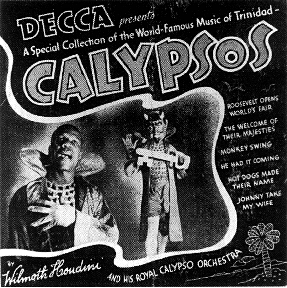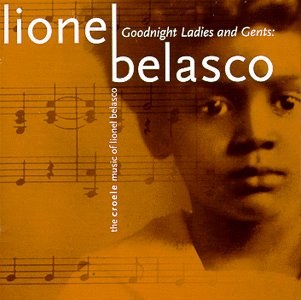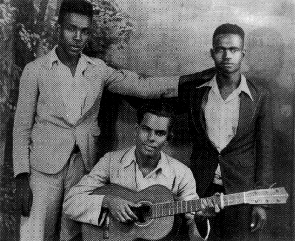
Jean and Dinah
Don't Go Joe
No Money, No Love
Obeah Wedding
Short Bio on Mighty Sparrow
Here Are the Best Calypso Options
 There are two main styles of Calypso to be explore on CD. The first is the 1920-1940 period, which is covered nicely by Rounder Records and available through Amazon (see below). The other is the 1950's calypso from the legendary Mighty Sparrow and Lord Kitchener among others. Kitchener and Sparrow songs have the most wit and humor of the Calypsonian's that I've heard. They're available on ICE records. There are several CD's for each artist, but volume one is superior in both cases. The 1950's calypso recordings sound more refined with much clearer vocals, but I still spend more time with the older recordings for reasons that are unclear to me. The above Mighty Sparrow lyrics all came from Mighty Sparrow volume one (Ice records).
[Nora]
[Doctor Kitch]
[Tie Tongue Mopsy]
There are two main styles of Calypso to be explore on CD. The first is the 1920-1940 period, which is covered nicely by Rounder Records and available through Amazon (see below). The other is the 1950's calypso from the legendary Mighty Sparrow and Lord Kitchener among others. Kitchener and Sparrow songs have the most wit and humor of the Calypsonian's that I've heard. They're available on ICE records. There are several CD's for each artist, but volume one is superior in both cases. The 1950's calypso recordings sound more refined with much clearer vocals, but I still spend more time with the older recordings for reasons that are unclear to me. The above Mighty Sparrow lyrics all came from Mighty Sparrow volume one (Ice records).
[Nora]
[Doctor Kitch]
[Tie Tongue Mopsy]
Note: The bastards at Amazon have arbitrarily sampled the first several tracks on each CD, so realize that those songs are not nearly the best examples from each CD.
- Calypso Calaloo (1914-1950)
Excellent CD with a focus on the earliest available recordings and religious roots of Calypso music. It would be useless to single out individual tracks from this album as each one is totally unique and interesting for different reasons (roughly translated: I'll get around to it later). Also has great liner notes that explain the origins of each track and will help you get started in your pursuit of this wonderful music. [AWC] [YS] [L]
- Calypso Carnival (1936-1941)
Track 3 & 20 - Si-O-No-Valse & La Rosa-Valse are both gems from the Gerald Clark Orchestra. These are two smooth instrumentals with a deceptive tempo.
Track 6 - In Depression-Pasillo, Lionel Belasco shows why he is the master of the "lure you to your death" rhythm.
Track 13 & 22 - Marabella Wedding & Point Cumana (better) showcase Tiger's strong singing accent, which is dotted with an occasional voice break. He also uses a lot of French, which is always great to hear when not spoken by a French person. Tiger has a fantastic way of rolling several words together into one phonetic bomb. To my taste, Tiger is one of the sweetest Calypsonians to listen to.
Track 14 - Wilmoth Houdini has perhaps the eeriest voice of all Calypsonians. That's his picture you see on the opening page, and his voice is no less spooky. Mama, Call the Fire Brigade also has some nice picking, good back up vocals, and is just a good song in general.
Track 15 - Anything For Love Tango Calypso is "just an old-fashioned love song" and a sweet instrumental from Harmony King's Orchestra.
Track 16 - Lion also has a crisp voice and a rapid, consonantal delivery as shown on Vitalogy.
Track 19 - King Radio doesn't have the prettiest Calypso voice by any stretch, but in John O'Carr, the music is just right, and the lyrics and chorus are equally catchy.
- Calypso Breakaway (1927-1941)
one fine calypso cd you don't have listed is the non-rounder golden age of calypso. on some french label--i got it off amazon a couple years ago. it starts off with a bunch of lion tracks. then there's the smithsonian folkways cook recordings, oh what's it called, calypso awakening. that's what got me into the whole pit in the first place. but, if you're crazy enough, all those rounder lomax carribean recordings are the next step... there's some quadrilles on a couple of them that'll eat your lunch for you. -- Ben
Track 1 - Don't Le' Me Mother Know by The Keskidee Trio has a catchy chorus.
Track 3 - It's the return of the laughing woodwinds and mysterious vocals heard on Calypso Calaloo with Felix and His Crazy Kats and Bei Mir Bist Du Schoen.
Track 9 - Lord Beginner's Anacoana is as tightly wound and catchy as any Calypso song I've heard. It tells an amusing story and is peppered with the kind of expressions that could save us all from blandness. "A real red-hot mama…when she walk and she glide up, and she slip and she slide up." "…and she had them so crazy…She can really Breakaway!." The title is also a clever pun, which I will let you figure out.
Track 12 - More Lionel Belasco brilliance with Violets-Venezuelan Waltz.
Track 16 - Every art form has the tale of jealous retribution. In Jamaica, we had Prince Buster who sang about it in his Ten Commandments (From Man to Woman). And then there was the great ska trombonist Don "O.J." Drummond, who didn't sing about it, but just did it real NFL style. In the nineties, we had Sublime with their hit Santeria. "I'll pop a cap in Sancho then I'll smack her down." And who better than Wilmoth Houdini to represent the Calypsonians in this time-honored tradition with Johnnie Take My Wife. "Ah looka misery, wherever I see Johnny. People come from miles around to see, the grave for Johnny and the gallows for me!"
Track 20 - Not sponsored by Nike. Nor on your television box. Not educated at Princeton. This is the original Tiger singing like only he can on The Whe Whe Banker Wedding.
- Calypso Pioneers (1912-1937)
Track 8 & 9 - Wilmoth Houdini is at it again with Caroline, asking "Where you sleep last night Caroline?" This track is followed by an instrumental version of the same song from Lionel Belasco. Credit Rounder for knowing how to arrange a CD. This theme would appear some 40 years later in Professor Longhair's Tipitina. "Luberta, oh Luberta, Girl you tell me where you been! When you come home this morning, you had your belly full of gin!" In the nineties, we have Nirvana's unplugged version of the Huddie Ledbetter song, in which Kurt Cobain asks "Where did you sleep last night?" Of course, in the eighties, Boy George got mad at his girl too. She would take his eye liner and all his hairspray without asking, then she would stay out all night and not bring the items back until the next day. He never wrote a song about it, however. He was too pissed for words.
Track 11 - Gerald Clark is his bad instrumental self with Carmelita.
Track 13 & 14 - Wilmoth Houdini's War Declaration and Lord Executor's My Reply to Houdini are classic examples that capture the fabulous trash talking that went on between the great Calypsonians who were always trying to one up each other. This competitive scenario is in stark contrast to today's rap musicians who avoid stepping on each other's toes as it might hinder their collective effort to redistribute the allowances of white teenage boys.
Track 16 - The Keksidee Trio brings it home with Congo Bara, a flat out smash in which you can feel the energy and fun these three singers are having as they pass the mike. And this is some 60 years before songs like Intergalatic by the Beasty Boys.
- Goodnight Ladies and Gents (1961,1999)


Before: I'm getting this album ASAP. Lionel Belasco is a jazz master putting piano and violin together like so much peanut butter and chocolate. An entire album of his stuff is what I've been dreaming of since I first heard him on Calypso Carnival a few years ago. Wow. Most things in the world are getting worse with time, but Rounder Records is definitely not one of them.
After: Oh my God! This album is awesome. This is the most haunting, melancholy music I've ever heard, maybe. If you've ever walked alone on a planked porch on a Summer night down South or on the deck of a cruise ship at night (you bring the $2000, we'll supply the breeze), this music will bring it back.Track 2 - Roses of Caracas Waltz - rhythm
Track 5 - Miranda - Piano and woodwind create a charming waltz between two masked carnival-ers, one of whom I suppose could be named Miranda. Think of Black Orpheus when you listen to this track.
Track 7 - Venezuelan Little Tune slows it down with very sweet piano. Here, Belasco plays alone in New York in 1961, long after the fuss is over.
Track 10 - Sly Mongoose
Track 11 - Carmencita - sweet rhythm
Track 13 - Maysotis - sweet rhythm
Track 15 - Caracas - sweet lilting melodies
Track 19 - The Palms of Maracaibo is the ultimate in mellow and has Latin flavor with mariachi and trumpet, or their equivalent.
Track 27 - Venezuela is very haunting indeed. This is my idea of a Calypso song. It's what you should be hearing now. If you have a problem with the hiss, than get the hell off my site. The link takes you to where it should be heard in its proper context.- Calypso At Midnight (1946)
Yes, but only after you've already got all the others mentioned here.
- Calypso After Midnight (1946)
Same as above. - Goodnight Ladies and Gents (1961,1999)
Recommended Reading
And if you really want to learn about the history of Calypso music and carnival in Trinidad, the best book to get is Calypso Calaloo: Early Carnival Music of Trinidad (1993). The paperback version is currently out of print, but if you're serious, you can still get the hardcover version which also comes with its own CD.
